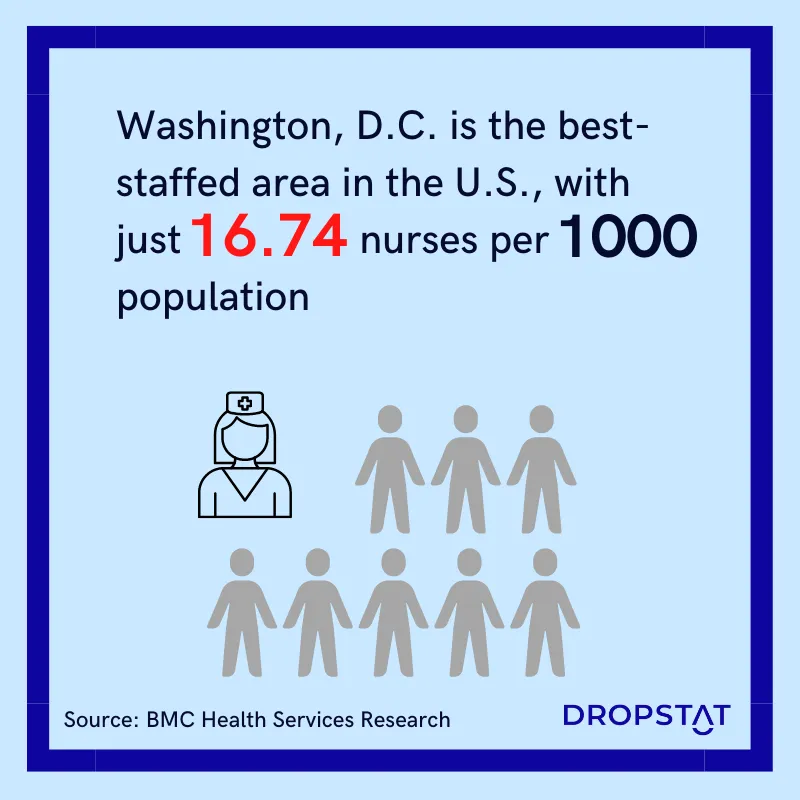But what led to this dangerous cycle, and most importantly, are there any cures? Surely, the COVID-19 Pandemic has exacerbated the severe threat of the nursing shortage to the healthcare system. However, unsafe staffing, burnout, and decreasing retention rates were issues before the pandemic started.
Shortage of Nurses in Hospitals
The nursing shortage creates adverse work environments for the nurses attempting to fill the gaps. In addition, it causes countless challenges for patients, other staff, and hospital management. A group of nurses from Centinela Hospital in California stated that “they are severely understaffed and sometimes forced to work 12-hour shifts without a break.” As a result, more than 220 nurses resigned from the hospital in 2020, and “after hiring nurses to fill the positions, the hospital is still short around 60 nurses as of August 2021.” This staffing shortage will likely cause greater burnout among the nurses filling the demand.
In a similar situation at USC’s Keck Hospital, nurses noted that “patients’ safety is jeopardized by chronic short staffing and the hospital’s excessive reliance on outside contractors without the appropriate experience and knowledge to provide safe care…”. This is a wide-reaching and growing issue.
In an extreme case, the Northpointe Healthcare Center in Fresno incurred a fine of $912,404 from the federal government and “immediate jeopardy” as a sanction by inspectors. The nursing home staff informed the inspectors that “they were stretched so thin they sometimes skipped treatments and failed to distribute medications.” “One resident was hospitalized with sepsis after missing four doses of an antibiotic.”
Similarly, CMS enacted a “notice of termination” at Good Samaritan Hospital in the Bay Area, which would discontinue payment for patients with Medicare or Medicaid. After reviewing the staffing records, a report noted that “for the week of 8/11/19 to 8/17/19, mandatory staffing ratios were not met on 5 of 7 days.” Not only does insufficient staffing strain nurses who are expected to fill the demand, but it also creates unsafe staff-patient ratios, increases unnecessary staffing costs acquired through agencies, and reduces the quality of patient care.

Factors Contributing to the nursing shortage in 2022
Though the global community is facing a shortage of nurses now, according to the World Health Organization, “it was estimated that by 2022 there would be a shortage of 7.2 million health workers worldwide. By 2035 the demand for nurses is predicted to reach 12.9 million.” Another U.S. Bureau of Labor Statistics report indicates, “Approximately 194,500 openings for registered nurses are projected each year.” Though this figure is high, it was approximated before the pandemic when droves of healthcare workers decided to leave their jobs in the healthcare setting.
According to the Nurse Journal, as of August 2022, the main factors contributing to the nursing shortage are:
- An increase in the demand for care of the aging population
- Many senior nurses approaching retirement age
- A high nurse turnover rate
- A lack of educators and faculty in the nursing field
Increased demand for aging population care
A report from the U.S. Census Bureau estimates that by 2030, the entire baby boomer generation will be over 65 (73 million individuals). Accordingly, they will require health care services that reflect their health conditions and nurses to support these efforts.
Senior nurses approaching retirement age
Peter I. Buerhaus, Ph.D., noted in 2017 that by the year 2030, one million nurses would retire, as they, too, are part of the baby boomer generation. The nursing expertise they possess will depart with them, putting a strain on well-rounded patient care.
High nurse turnover rates
As of February 2022, the national average turnover rate for nurses was between 8.8% – 37.0%, according to the National Institutes of Health. Rising stress levels, along with increased burnout, influence this rising turnover.

Shortage of faculty and educators within nursing
The American Association of Colleges of Nursing (AACN) 2019 report notes that 80,407 eligible applicants were rejected from baccalaureate and graduate nursing programs mainly due to inadequate faculty. Additionally, they reported that among 829 nursing schools, there were 1,637 open faculty positions.
While unmet staffing needs are affecting other nurses, patient care is lacking as a direct result. Nurses working overtime or taking longer shifts to fill the gaps significantly increase the risk of making mistakes. Inadequate staffing is a direct cause of delayed or missed patient care. The nurses struggle to deliver medication on time, leading to prolonged hospital stays and reduced patient satisfaction. Insufficient staffing is a patient-safety hazard that can be mitigated through “organizational attention, quality improvement, and safety research” (Patient Safety Network).
Predicted difference between supply and demand of RN by 2030
| State | Predicted demand by 2030 | Predicted supply by 2030 | Difference |
| California | 387,900 | 343,400 | -44,500 |
| Texas | 269,300 | 253,400 | -15,900 |
| New Jersey | 102,200 | 90,800 | -11,400 |
| South Carolina | 62,500 | 52,100 | -10,400 |
| Alaska | 23,800 | 18,400 | -5,400 |
| Georgia | 101,000 | 98,800 | -2,200 |
| South Dakota | 13,600 | 11,700 | -1,900 |
Source: https://bhw.hrsa.gov/
FAQs About the Nurse Shortage
Why are nurses quitting their jobs?
Burnout and high-stress work environments are the no.1 factor causing nurses to quit their jobs. Nurses are also getting offered higher salaries in other companies, which motivates them to leave their jobs.
At what age do nurses retire?
The average retirement age for registered nurses is 58 years. Over two-thirds retire before the age of 65. Some of the main reasons why nurses retire early include; a heavy workload, lack of incentives to stay longer in the job, and wanting more freedom and time.
Which state has the highest nursing shortage?
Currently, Utah has the biggest shortage of RNs, with 23,760 employed RNs for a population of 3,271,616. That’s just 7.26 RNs per 1000 people!
By 2030, however, California is expected to have the highest shortage of registered nurses, with an estimated deficit of 44,500. This is nearly 3 times the projected deficit in Texas, the next shortest state.
What is the US Government doing about the shortage of nurses?
Almost every state has taken action to help with the nursing staff shortage. The CARES Act has given funding for training nursing students in areas with nursing shortages.
Hospital Nurse Shortages Increase Patient Mortality Rates
The issue of unsafe staffing within gap-shift management significantly contributes to inefficient use of resources and compromised patient care. A longitudinal study published by the Journal of Nursing Scholarship found when patients spent time in units with temporary staff, their risk of dying increased.
“We found that each day a patient was exposed to more than 1.5 hours of temporary RN staffing, the risk of death increased by 12%. To add to this, National Nurses United testimony from RN Nerissa Black in 2021 states that unsafe staffing ratios caused her to take risks to her well-being to care for patients when the hospital was short on staff. She later explains that the stress of understaffing caused her to resign. However, she later returned to the hospital to support patient care and safe staffing legislation. This testimony highlights how safe staffing ratios decrease unnecessary costs, burnout, and inadequate patient care while increasing retention rates.

Cures to the Nursing Shortage
Congress has enacted the CARES Act to help prevent the devastating effects of the nursing shortage. Title VIII offers:
- Funding to train more R.N.s in communities suffering from the shortage.
- Loan repayment and scholarship programs for nurses who practice in facilities with a shortage.
- Grants for nurse education, practice, and retention to assist nurses with an associate or baccalaureate degree.
- Loans for faculty development within nursing and grants for advanced nursing education and diversity.
An article from the Nurse Journal notes that retention rates will also increase by focusing on improving the workplace culture, such as the mental health of nurses and work/life balance. Additionally, the article states that retention rates can increase when facilities focus on hiring the right clinical leaders, rely more on the internal nurse float pool, and decrease dependency on travel nurses. This provides more appreciation for internal nurses.
Lastly, new nurses may be willing to take extra shifts by providing financial incentives. The CNO of IntelyCare explains that reducing the length of shifts and overtime has been shown to increase retention rates.
How Dropstat Helps Combat the Nursing Shortage
Dropstat’s software was designed with the nursing shortage crisis in mind, and its programs help combat it. The scheduling interface allows bulk shift uploads, duplicating, and editing shifts to make it easy to map out shift fills and staffing needs months in advance. Having a clear picture of gap shifts with plenty of lead time to manage those gaps is key to Dropstat’s innovative safe staffing methods. Beyond scheduling, the platform boasts a rewards program to boost staff engagement and encourage them to pick up open shifts.
While the platform is designed to utilize in-house staff first, some agency use will also be required. With this knowledge, the platform enables schedulers to communicate with agencies to fill staffing needs. The automatic approval process allows the platform to accept staff for shifts with the required qualifications after reviewing the cost analysis.
Alongside the platform’s numerous features, it also integrates with other scheduling and time management programs.
The elements of Dropstat’s platform and its specialized features create a program through which the nursing shortage crisis and its effects can be effectively managed and reduced. Click here to read about how workforce optimization can skyrocket your profitability, professionalism, and patient satisfaction.






